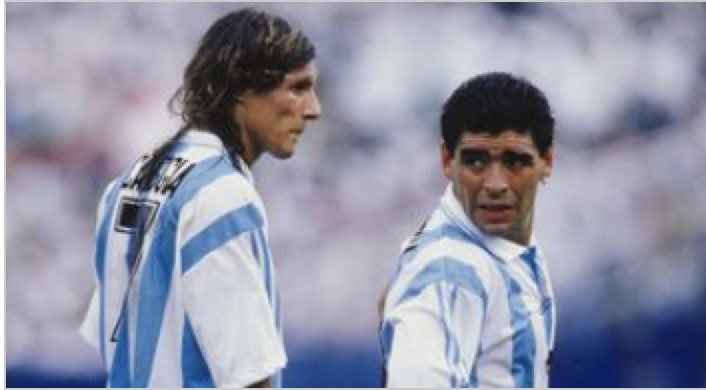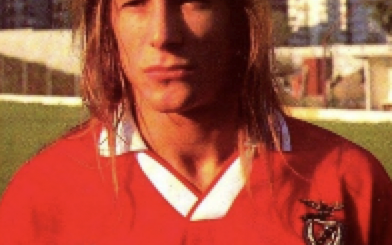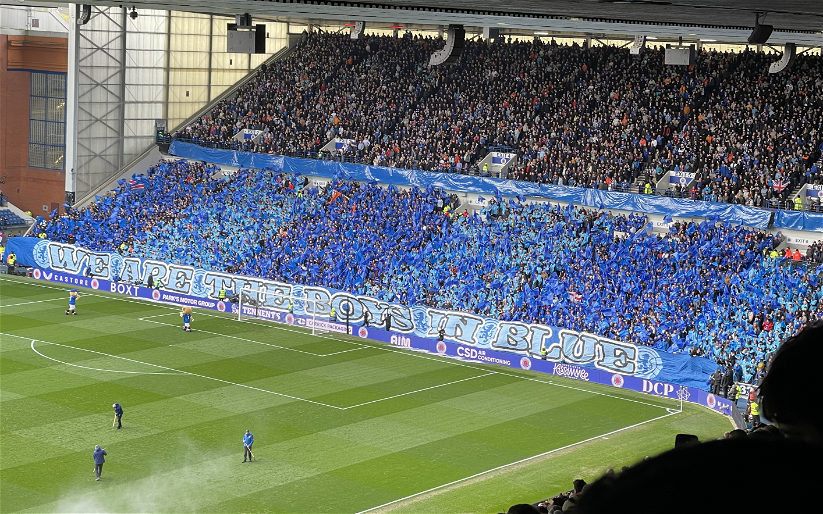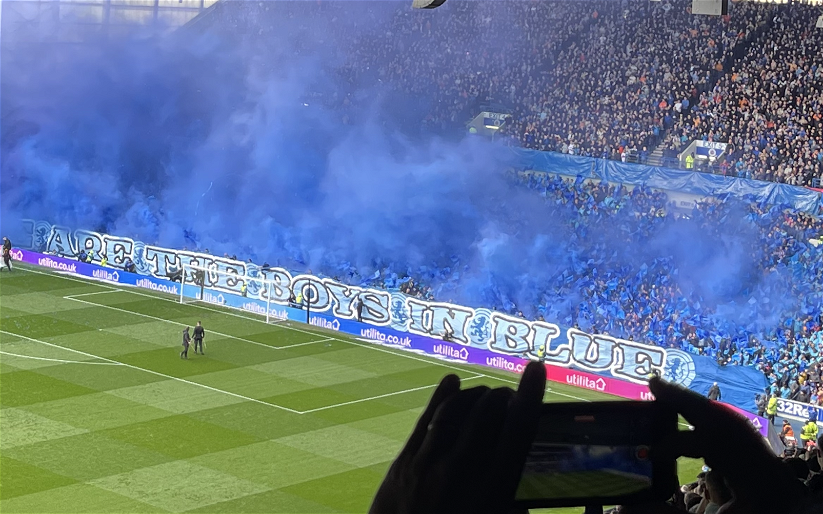By David Herd
When Rangers earned an excellent 2-2 draw in Lisbon last Thursday, they were up against a team with a budget that any Scottish team could only dream about. The two-times European champions and current Portuguese title-holders can’t afford to compete for the very best against the giants of the richest European leagues, but they can still boast a starting line-up that contains two current world champions. Club captain and central defender Nicolas Otimendi won his 100th cap for Argentina in the classic 2022 World Cup final shootout win against France, and has a CV that also includes two EPL titles, four English League Cups and the 2019 FA Cup with Manchester City. Meanwhile, out on the wing, first-leg penalty scorer Angel Di Maria was the scorer of Argentina’s second goal in that world final in Qatar, and in his career he has won five French titles with PSG as well as both La Liga and the Champions League with Real Madrid. He has played 136 times for his country, and played alongside Otimendi when Argentina won the 2012 Copa America.
But there was another Argentinian who played for Benfica almost three decades ago who didn’t win the ultimate prize that these two modern stars have claimed. He did star on the world stage, however, and despite his medal haul being less impressive, he was a better footballer than either of them. His name was Claudio Caniggia, and he did something neither Otimendi nor Di Maria will ever do. He wore the royal blue of Rangers.
Born in 1967, Caniggia started his football journey at River Plate, where he was a title winner as a teenager, as well as a winner of the Champions League of South America, the Copas Libertadores. The quick and direct forward was scouted by Serie A side Hellas Verona, and they brought him to European football in 1988. Although not one of the fashionable clubs in Italy, Hellas Verona had been surprise league champions just three years earlier, and they were a comfortable mid-table side at the time of Caniggia’s arrival. He was a regular in the side in his only season in Verona, before a move the following summer to Atalanta, a team who had qualified for the UEFA Cup by finishing the season sixth. This was a transfer with a Rangers connection, as Swedish international midfielder and former Ibrox man Robert Prytz moved in the opposite direction as part of the deal. Caniggia would play there for three years, during which time he would come to worldwide attention thanks to the 1990 World Cup, played in Italy.
Caniggia had made his international debut in 1987, and was a fixture in the Argentinian team in the 1989 Copa America, where he scored winning goals against both Chile and Uruguay before the world champions failed to top the final group stage which was won by hosts Brazil. This helped make him a well-known face back home, but he was something of an unknown to the wider football public when the World Cup kicked off in June 1990 with a match between holders Argentina and rank outsiders Cameroon. The man whose face was known the world over, Argentinian captain and footballing superstar Diego Maradona, was the man who dominated the game. And like Caniggia, he plied his club trade in Italy, where he had achieved God status in the city of Naples.

At the time, Italy was the richest and most successful league in the world, with most of the game’s greats starring for Italian club sides. All three of UEFA’s club competitions were won by Italian teams in 1990, emphasising this dominance. Amongst the tournament favourites, Argentina had six Italian-based players, European champions Holland had the Milan triumvirate of Gullit, Van Basten and Rijkaard, while the Germans had the Inter trio of Klinsmann, Matthaus and Brehme as well as Rudi Voller of Roma. Meanwhile Brazil, the South American champions, had a team built around players like Careca of Napoli, Dunga of Fiorentina and Muller of Torino. Caniggia of Atalanta was very much a supporting act at this stage, but he would go on to make a bigger impact in Italia 90 than many of these global names.
He started on the bench in the opener, coming on in the second half as the holders struggled to break down their energetic and physical opponents from Africa. Cameroon shocked the footballing world by winning 1-0, but they ended the match with just nine men, with their second red card for defender Benjamin Massing becoming one of the most infamous assaults ever seen on the world stage. With just two minutes left, and the Argentinian team desperately seeking an equaliser, Caniggia’s pace saw him take possession deep inside his own half and race towards the Cameroon half. He managed to avoid two lunging tackles as he sped towards the danger area, only for Massing to brutally stop his progress with a waist-high kick at his opponent. Caniggia rolled in agony, the player was sent off, and the millions watching saw the beautiful game’s ugly side.
He was able to recover in time to play in the next match, a vital win over Euro runners-up the Soviet Union in front of Maradona’s adoring Naples public. A draw against Romania that suited both sides meant that Argentina had qualified for the last 16, and an early showdown with arch-rivals Brazil. This would be the game that Caniggia cemented his status as one of the stars of the tournament. It was a match that Brazil dominated, with Argentina grateful on several occasions for the goalkeeping of Sergio Goycochea. Then with just ten minutes left, Maradona suddenly came to life, striding past two despairing tackles before slipping the ball through to Caniggia as the remaining defenders looked to crowd him out. The Atalanta forward finished superbly, the Argentinian players and fans celebrated wildly, and Brazil were out.
Caniggia was now a national hero, and his partnership with Maradona was something feared by the teams left in the competition. They failed to break down a stubborn Yugoslavia in the quarter-finals but prevailed on penalties, meaning a semi-final that Hollywood scriptwriters couldn’t have set up any better. Hosts Italy against holders Argentina, to be played in the city of Naples where the visiting captain was revered like no other man alive.
The Italians hadn’t conceded a goal in the tournament, and in striker Toto Schillachi they had unearthed the competition’s deadliest penalty box goalscorer. They were the team the bookies favoured to win it, and those odds looked justified when Schillachi scored before 20 minutes had elapsed. But in a strange atmosphere, with the Naples crowd seemingly supporting both Italy and Maradona, the hosts never took advantage of their good start and didn’t get the kind of lift from the stands that they had enjoyed in other venues. Things got nervy, and midway through the second half it was Caniggia who crushed Italian hopes when he ghosted into the box to get on the end of a cross and cleverly head home. There were no further goals, and the Italian hosts missed twice in the penalty shootout, meaning Argentina and West Germany would compete in the final just as they had four years earlier. But for Caniggia, there was heartbreak amongst the joy, he had picked up a booking in the 82nd minute for deliberate handball, and combined with a yellow he had been given in the group match against the Soviets three weeks earlier, it meant he was suspended for the biggest match on Earth. A similar fate would have befallen England’s Paul Gascoigne if England had won the penalty shootout in the other semi-final, after he was booked against the Germans.
Without Caniggia, Argentina looked insipid up front in the final, and they lost 1-0 to a late German penalty kick. Many observers felt that one of the best players in the competition missing the biggest game due to just two bookings in six tournament appearances was harsh in the extreme, and it had somewhat spoiled the spectacle. The player himself was in no doubt, saying years later “had I played, we would have won.” Eventually the rules on yellow card suspensions would relax, with bookings received prior to the semi-finals now disregarded once the competition reaches the last four.
Despite not getting his hands on the gold trophy, Caniggia was now hot property. He was voted Player of the Tournament at the Copa America the following year, scoring twice and providing four assists as Argentina won the trophy. In 1992, he scored in the Confederation Cup final win over Saudi Arabia as Argentina lifted more silverware. That same year, he moved to Roma, a club who had ambitions on the Serie A crown, and he was seen as one of the biggest names in the sport. But in March 1993, his career ground to a spectacular and self-inflicted halt. After a match against Napoli, Caniggia was selected for a random drugs test. When traces of cocaine were found, it meant a year-long ban from the game, and a similar shame as his great friend and teammate Maradona.
After his ban, Roma were unwilling to risk such a controversial player in their ranks, and a loan move was arranged for season 1994/95. The destination was Benfica. This came after a comeback at international level just before the 1994 World Cup after his year out of the game was completed. He scored twice in USA 1994, but Argentina went out in the last 16 and Maradona’s failed drugs test completed a terrible time for the player and the country.
In Portugal, he was able to get back playing regularly again, although without any great success. He scored a respectable 16 goals in 34 competitive appearances for Benfica, including two in the Champions League group stage, helping the team to top their group before being eliminated in the quarter-finals by holders AC Milan. Domestically, a third place finish in the league was viewed as failure, and this wasn’t helped by home and away defeats to Sporting in the city derby. The home defeat on 30 April 1995 would see Caniggia make the headlines again.
Sporting won the game 2-1, but the result was overshadowed by a terrible refereeing error. Caniggia was shown a yellow and then a red card for his part in an altercation, and despite pointing out to the referee that he had never received a first yellow card, he was ordered from the pitch. The player had been correct, he was not cautioned earlier in the game, the referee had written down the wrong number when dishing out a previous booking. Benfica appealed to the Portuguese FA to have the result annulled, and to the great surprise of most within football, the authorities agreed. Benfica then won the replayed game 2-0, which was played despite a Sporting appeal ongoing. FIFA then stepped in, and ordered the original result to stand, leaving the whole of Portuguese football amazed at how one incompetent decision could so quickly escalate to even worse.
Caniggia left Lisbon after that one year, and returned home to Argentina, where he joined his old club’s most deadly rivals Boca Juniors, where he would team up again with Maradona. The pair undoubtedly enjoyed being together on and off the pitch, with the latter not being ideal for success in the former. Caniggia’s wife was quoted as joking “At times I think Diego is in love with my husband, It must be the long hair and big muscles!” No doubt their exploits in the nightclubs were legendary, but Boca failed to lift any trophies with their dream pairing up front, and a midfield that contained future Manchester United man Juan Sebastain Veron.
After two seasons, he returned to the Italian city of Bergamo to rejoin Atalanta, the place where he said he had most enjoyed his football. The club were now in Serie B, and although the fans hailed the return of their former hero, he was unable to get the team back towards top flight football, and when he left in 2000, it appeared his career was all but over at the age of 33. Then came a surprise Indian Summer in a very surprising place. Claudio Caniggia joined Dundee.
Manager Ivano Bonetti was assembling a cosmopolitan team at Dens Park, with Caniggia the big attraction. Many doubted the move would work, but the player enjoyed a new lease of life. He made 24 starts and 1 substitute appearance in season 2000/01, as Dundee finished a highly respectable sixth. And amongst his eight goals were strikes in the derby against Dundee United, and an opener at Ibrox in a shock 2-0 defeat of Dick Advocaat’s expensive team. Playing on the right side of the attack, Caniggia’s pace gave the best Scottish defences plenty problems, and he set up many of the goals scored by the other forwards. This attracted the attention of Advocaat, and in the summer of 2001 he paid Dundee £900,000 to sign the player on a two-year contract. Caniggia immediately endeared himself to his new fans by declaring “I feel very good to be at Glasgow Rangers because I know they are great club, with a great history and they have good players. Celtic and Rangers are the two best teams in Scotland and, for me, Rangers are the best team in Scotland.”
On the day he said that, Celtic were holders of the treble. When Caniggia left the club in June 2003, he had proven himself totally correct. In those two seasons, he made 45 starts and came off the bench a further 33 times. From that wide right position, he scored a very impressive 21 goals, with some of them absolutely vital. He scored on his league debut at Pittodrie on the opening day of the 2001/02 season, and followed it up with a double in his Ibrox debut a few days later in a Champions League qualifier against Maribor. At 34, he was rotated regularly in and out of the team, and at the start things didn’t go too well as Martin O’Neill’s Celtic continued to dominate. By December, the gap to Celtic was already an impossible one, and Advocaat made way for Alex McLeish. The new manager implemented a 4-3-3 system, with great initial success.

Caniggia started as Rangers finally beat their old rivals in the League Cup semi-final, a night famous for a Bert Konterman bullet. That meant a final against unfancied Ayr United, and it was Caniggia who scored goals three and four as the underdogs were eventually beaten 4-0. That first winner’s medal in Scottish football was soon joined by a second. In a classic Scottish Cup final against Celtic, Rangers won 3-2 thanks to a 93rd minute winner by Peter Lovenkrands. Caniggia had started that day, but had been forced off the field early in the first half after receiving a shoulder injury in a bad challenge by Chris Sutton, the Celtic player blatantly body checking the Rangers winger after Caniggia had looked threatening in the opening exchanges.
Season 2002/03 would continue the Caniggia silverware collection. He scored his only Rangers hat-trick in his first outing of the campaign as Dunfermline were hit for six, something that would happen again before the season was over. Rangers and Celtic slugged it out at the top of the table, both teams showing great consistency and pulling miles ahead of the rest. In the League Cup, Caniggia scored in a tense 3-2 win at Easter Road in the last 16, then grabbed the only goal in a nervy win at East End Park. Inevitably, the Old Firm would meet again in the final.
At a packed Hampden, Caniggia struck first midway through the first half, knocking the ball home at the back post and scoring for the second League Cup final in a row. He is still the last Rangers player to score in the final in successive years. Lovenkrands had doubled the lead by the interval, and although Celtic pulled one back in the second half, the cup was retained when John Hartson missed a 90th minute penalty, just a few minutes after Neil Lennon had been sent off.
With the first trophy now secured, Rangers went after a treble. After being five points ahead going into the split, a home defeat by Celtic and a draw at Dundee (when Barry Ferguson missed two penalties) meant no room for error. Rangers and Celtic were now level, with only a slim goal difference favouring Rangers. The last weeks became a shootout. And Caniggia helped fire the team to glory. He scored in a brilliant 4-0 home win over Kilmarnock at Ibrox, then hit the second goal in the epic 6-1 win over Dunfermline on the final day that saw the title won by the narrowest margin as the nerves of every supporter were tested to their limit.
Caniggia scored six times against Dunfermline that season, with his equaliser in the Scottish Cup at East End Park earning a replay in the quarter-final. Unfortunately, he picked up a knock in that final league fixture against them, meaning he missed the final and the treble-clinching win against Dundee. While a Rangers player, he was called back into the Argentina squad for the 2002 World Cup, with his old friend Maradona insisting he should start in their opening match. “Cani has always kept the holy fire of an extraordinary forward” declared Diego. “His experience can be vital, I believe he should start the games”. Coach Marcelo Bielsa disagreed, and left him on the bench against Nigeria, England and Sweden. His frustration at not being called upon boiled over in the last match as Sweden earned the draw they needed to knock out Bielsa’s team. He verbally abused referee Mr Bujsaim of the United Arab Emirates, and became the first player ever red carded in a World Cup without playing a single minute!
Caniggia left Rangers in the wake of that treble success, club finances meaning that several of the squad were allowed to leave. He spoke of his desire to stay, but his short but hugely successful Ibrox career was over. After a short spell in Qatar, he retired from football in 2004. His trademark speed and long flowing blond hair, which earned him the nickname “The Son of the Wind” wouldn’t be seen again in professional football. A player who enjoyed life off the pitch, and who was a friend and much respected teammate of possibly the greatest footballer ever. And the playboy image was further enhanced in 2019, when at 52 Caniggia announced he was divorcing his wife of many years and was to marry a 26-year-old fashion model.
Claudio Paul Caniggia, the best player to have played for Benfica and for Rangers.




